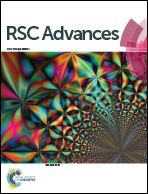Robust electrospinning cellulose acetate@TiO2 ultrafine fibers for dyeing water treatment by photocatalytic reactions
Abstract
Cellulose acetate (CA) composite ultrafine fibers containing different TiO2 nanoparticle (NP) contents were synthesized via electrospinning for effective dyeing water treatment. Morphology, chemical composition, microstructure, thermal properties and photocatalytic degradation efficiency of the fabricated composite ultrafine fibers were investigated. Scanning Electron Microscopy (SEM) and Transmission Electron Microscopy (TEM) images revealed that TiO2 NPs were evenly dispersed on or into the composite ultrafine fibers and the distribution became denser as the concentration of TiO2 NPs increased. This was also confirmed by Energy Dispersive Spectrometry (EDS), X-ray diffraction (XRD) and Fourier Transform Infrared Spectrometry (FTIR) analyses. Moreover, the results of XRD showed that the crystal structure of the TiO2 NPs was tetragonal anatase and the TiO2 NPs enhanced the amorphous phase of the electrospun composite ultrafine fibers. FTIR indicated that the introduction of TiO2 did not affect the hydrophilic properties of CA and some interaction took place between CA and TiO2. Thermal gravimetric (TG) analysis showed that the addition of TiO2 improved the thermal stability of the CA ultrafine fibers, and a higher thermal stability could be achieved with a higher TiO2 content. Photocatalytic degradation of the dye showed that a higher reaction constant of the photocatalytic degradation of the dye could be obtained with a higher TiO2 content, with a degradation efficiency of the CA composite ultrafine fibers with 5 wt% TiO2 as high as 90% after 240 min degradation. The composite ultrafine fibers were effective for cycling use in dyeing water treatment.


 Please wait while we load your content...
Please wait while we load your content...